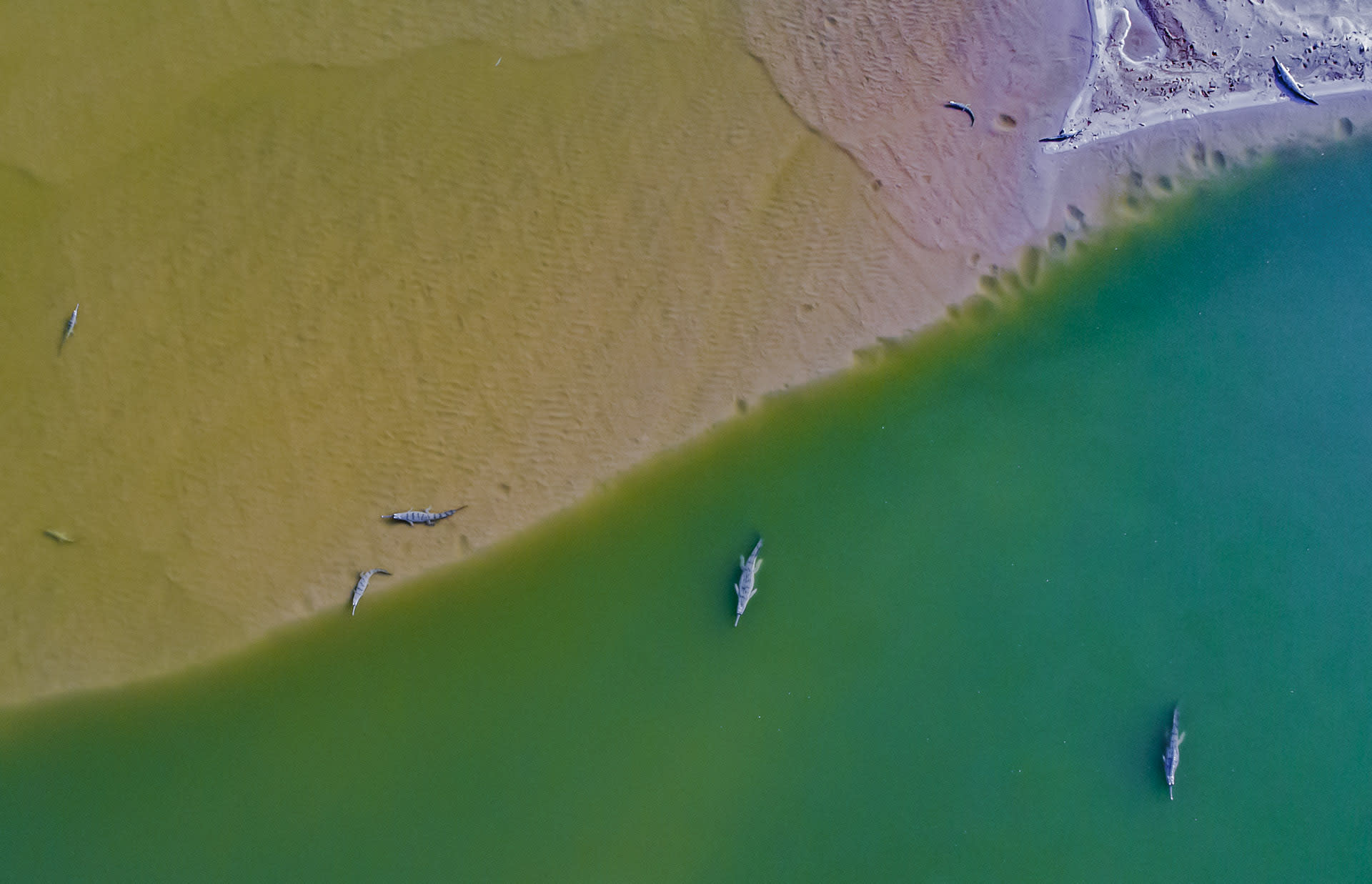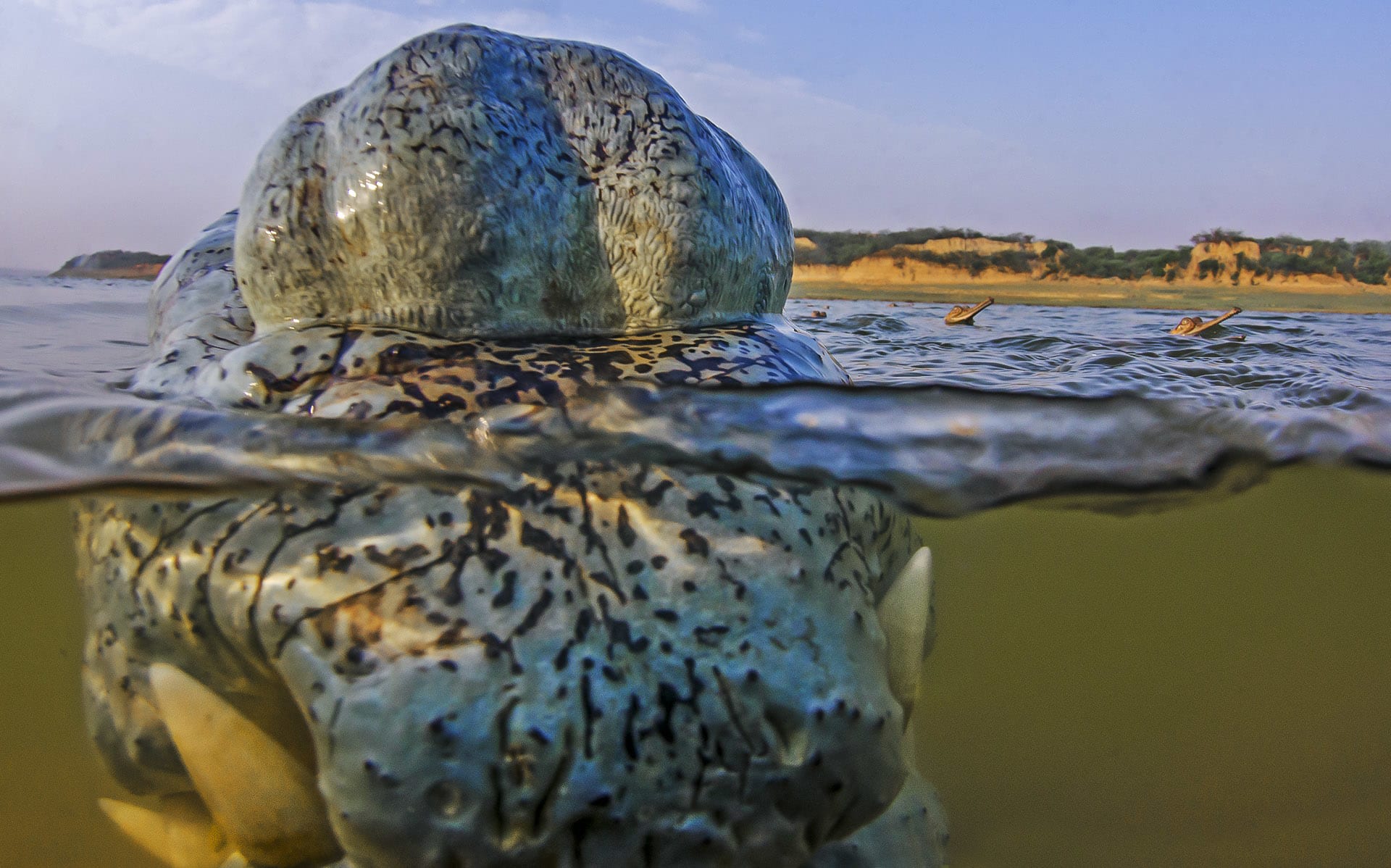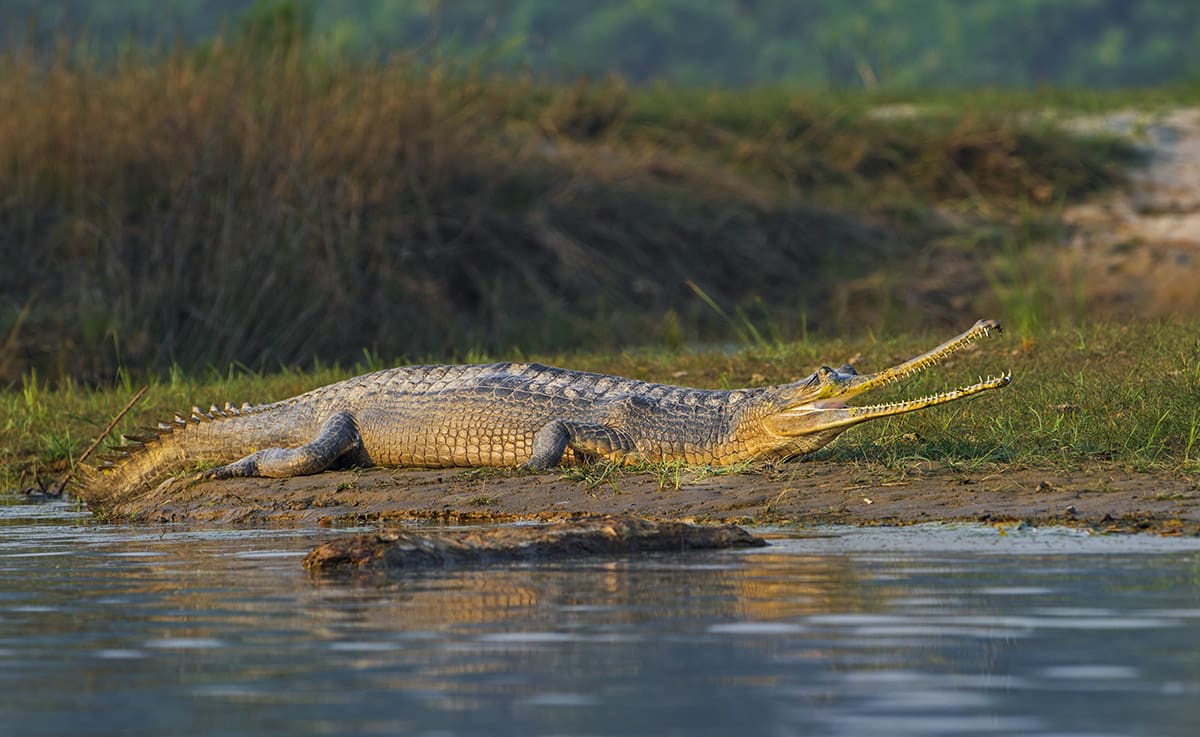A boat safari in the National Chambal Sanctuary is richly rewarding. The reserve encompasses parts of Rajasthan, Uttar Pradesh, and Madhya Pradesh and supports populations of numerous terrestrial and aquatic species, including the critically endangered gharial (Gavialis gangeticus). The slender-snouted, sharp-toothed reptiles regulate their body temperature by sunbathing to generate warmth or immersing themselves in water to cool down. Their mouths are often open while basking in the sun. This gaping behaviour helps keep them cool while the body warms up.
Gharials are endemic to freshwater rivers in Asia. According to WWF India, they were historically “found in the river system of India, Pakistan, Bangladesh, and southern parts of Bhutan and Nepal” but their distribution has dropped significantly in the last century. Gharial numbers were especially low in the 1970s, when studies estimated there were less than 200 left in the wild, triggering a series of conservation efforts that included breeding programmes to repopulate native habitats.
Today, their numbers have significantly improved, though their range remains severely compromised. Gharials are now found only in India and Nepal, in rivers including the Ganges, Girwa, Son, Ramganga, Gandak, Chambal, Mahanadi, and Narayani. In addition to the Chambal Valley, these fish-loving reptiles also have a safe home in the Ken Gharial Sanctuary in Madhya Pradesh, and the Gandak River in Bihar where “around 211 gharials of different age-groups are present in the river as compared to merely 15 recorded in 2010,” says an article on Mongabay from January 2019.
Wildlife photographer Dhritiman Mukherjee who photographed most of these gharials between 2012 and 2018 says, “Gharials are quite shy, but easy to see if one maintains distance. They can be seen basking in the sun, along the banks of the Chambal, especially in the wintertime.”

Gharials are considered the most aquatic members of the order Crocodilia, though they are not taxonomically considered “true crocodiles”. “The term “crocodilians” refers to all members of the Family Crocodylidae (“true” crocodiles), Family Alligatoridae (alligators and caimans) and Family Gavialidae (gharial, Tomistoma),” clarifies IUCN. “In contrast, the term “crocodiles” refers only to the ‘true’ crocodiles.” Physiologically, the differences between crocodiles, alligators, and gharials, lies in the shape of the head, jaws, and skull, though the different species have plenty in common as well. Photo: Dhritiman Mukherjee

The most distinctive characteristic of the gharial is its long, slender snout. Males also have a bulbous formation on their snouts, often compared to earthenware pots called gharas, after which the species is named. “Males use their gharas to vocalise and blow bubbles during mating displays,” according to National Geographic. Male gharials are much larger than females and can grow to 20 feet, while females are generally 11-15 feet. According to WWF India, “the ghara also renders the gharial the only visibly sexually dimorphic crocodilian.” Photo: Dhritiman Mukherjee

The first thing most humans notice about gharials are their teeth: spiky, razor-sharp, and too many to count. Unfortunately, this instantly plants fear in the minds of most people, even though gharials are mainly fish-eating reptiles. They use their teeth — over 100 in number — to catch slippery fish, which they consume in handsome quantities. Like many crocodilians, gharials have three eyelids: upper, lower, and an additional third lid that protects the eyes when they dive underwater to catch prey. Photo: Romulus Whitaker

Gharials mate in winter when water levels have dropped enough to reveal sand banks. Males mate with multiple females, following courtship displays involving loud vocalisations with the ghara, and jaw snaps, presumably to illustrate their physiological assets. Females lay 25-80 eggs in burrowed nests in the sand, which they dig with their hind feet. Young females have smaller clutch sizes but as they grow they lay more eggs, reaching to 70-80 eggs per clutch. Photo: Dhritiman Mukherjee

Females watch over the nest, but once the young are born, males take over where protection is concerned. Around May-June, when the hatchlings have emerged, male gharials can be seen carrying hundreds of babies on their heads and snouts, so they can bask in the sun, and warm their bodies. Survival rate of gharial young is very low. “There is a significant change in their behaviour at this time,” says Mukherjee. “During breeding season, they can be quite aggressive. Approach them, and they might attack, where otherwise they quietly slip into the water.” Photo: Dhritiman Mukherjee

Gharials are found only in freshwater habitats, so the health of the species is linked to the vitality of our river systems. Unfortunately for this endangered reptile, our rivers are under serious duress thanks to incessant damming, sandmining, largescale fishing activities, and the dumping of industrial effluence and plastic waste. Photo: Dhritiman Mukherjee

Gharial numbers have dropped almost 98 per cent since the 1940s, due to hunting and pollution of freshwater habitats. However, thanks to conservation efforts such as conservation breeding programmes their numbers are slowly increasing, though they are still very much in the red. We are also understanding their ecology, behaviour, habitat requirements and movement through satellite tagging research. Photo: Dhritiman Mukherjee

In May 2020, 40 tagged juveniles were released in the Ghaghara River, from the Kukrail Gharial Rehabilitation Centre in Lucknow. An article by Down to Earth magazine estimates that about 250 gharials have been released in the Ghaghara since 2014, but survival rates are hard to estimate. This image was taken at a breeding centre in Katarniaghat Wildlife Sanctuary, a part of Dudhwa Tiger Reserve, where gharials are bred for release in the Girwa River, which runs through the sanctuary. Some gharials have been released in other nearby rivers. Photo: Dhritiman Mukherjee

Much like tigers, gharials are considered keystone species that signify the health of their habitat. When gharial numbers start to drop, it is a signal that our riverine systems are under duress. So, in a sense, saving the gharial is as much about our own survival as a species, for without fresh water, the future of humanity seems just as unlikely. Photo: Dhritiman Mukherjee

